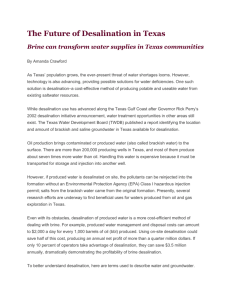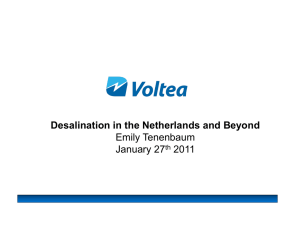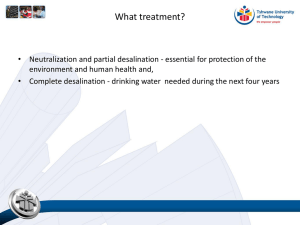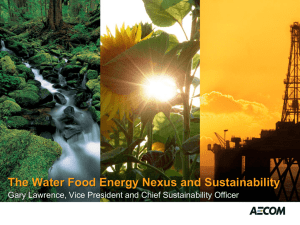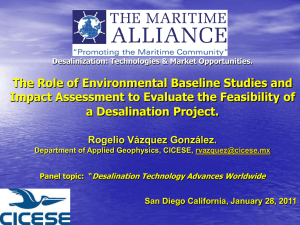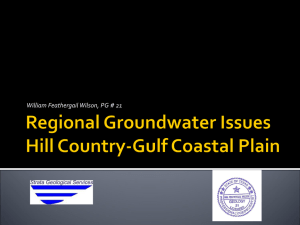brackish groundwater desalination effort in texas - Multi
advertisement
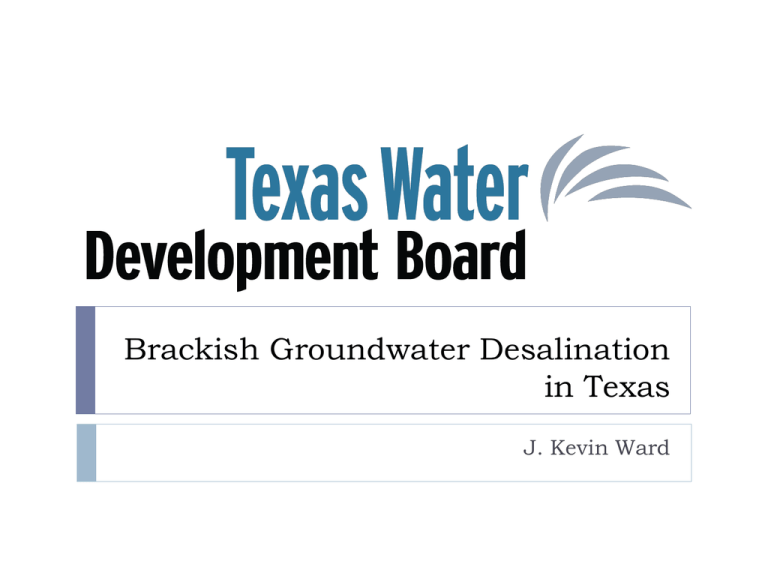
Brackish Groundwater Desalination in Texas J. Kevin Ward Texas Water Development Board To provide leadership, planning, financial assistance, information, and education for the conservation and responsible development of water for Texas 2011 Regional Water Plans Millions of Acre-Feet In a drought of record, Texas does not have enough existing supplies to meet demands 25 20 15 10 5 2010 2020 2030 Total Water Demands 2040 2050 Total Water Supply 2060 2011 Regional Water Plans Millions of Acre-Feet Water Management Strategies recommended to account for 9 million acre-feet of additional supplies in 2060 10 Seawater Desalination 9 Brush Control Weather Modification 8 Aquifer Storage & Recovery 7 Conjunctive use 6 Surface Water Desalination Other Surface Water 5 New Major Reservoir 4 Groundwater Desalination 3 Reuse Groundwater 2 Drought Management 1 Other Conservation Irrigation Conservation 2010 2020 2030 2040 2050 2060 Municipal Conservation Growth of desalination capacity in Texas 140 120 Number of Facilities Design Capacity (MGD) 120 Number of Facilities Design Capacity (MGD) 100 75 80 60 40 30 22 38 44 20 0 12 1999 14 2001 2005 Year 2010 Current desalination capacity in Texas Facilities ≥ 25,000 gallons per day Existing facilities 44 facilities 120 mgd Current desalination capacity in Texas Facilities ≥ 25,000 gallons per day Surface water 12 facilities 50 mgd Brackish groundwater 32 facilities 70 mgd Electrodialysis Reversal 2 facilities 11.1 mgd Reverse osmosis 42 facilities 108.9 mgd Key challenges to brackish groundwater desalination in Texas • • • • • Concentrate Energy Cost Permitting and regulations Source characterization Courtesy: North Alamo WSC TWDB’s Brackish Groundwater Desalination Program Courtesy: Southmost Regional WSC Purpose Identify challenges to implementing brackish groundwater desalination develop and demonstrate practical solutions Funding ~$1,800,000 specific for brackish demonstration projects ~$800,000 for brackish groundwater characterization Other funds: Research & Planning Program Projects funded Funded organizations Scopes of projects (examples) Operational Challenges City of Kenedy and San Antonio River Authority Economics of replacing aging technology with modern equipment Texas Tech University Operational efficiency of small-scale desalination systems Concentrate Management San Antonio Water System El Paso Water Utilities Increase recovery and concentrate volume reduction by mechanical means University of Texas at Austin Increase recovery and concentrate volume reduction by chemical means Bureau of Economic Geology Self-sealing mechanisms of evaporation ponds Energy Management Affordable Desalination Collaboration Assessing and optimizing energy management in reverse osmosis desalination of brackish sources Projects funded Funded organizations Scopes of projects (examples) Technology and Outreach North Cameron Regional WSC Desalination Guidance Manual Bureau of Economic Geology Texas Desalination Database Source Characterization City of San Angelo Source Characterization Guidance City of Seminole Dockum aquifer data Post-Treatment Carollo Engineers Study of calcite contactor beds and design guidance Regulations and Permitting CDM Test of regulations for use of Class II well for concentrate disposal North Alamo WSC Assessment of fiberglass casing for brackish wells Brackish Resources Aquifer Characterization System Characterize the brackish waters in much greater detail (to 10,000 mg/L total dissolved solids) Design database and GIS to process this new information Collect comprehensive well information statewide Research and develop methods of data analysis Document results in reports Provide access to raw and processed information Build replicable numerical groundwater flow models to estimate aquifer productivity Develop parameter-screening tool to help communities assess the viability of brackish groundwater desalination supplies Present study results nationwide Brackish Resources Aquifer Characterization System Technical Review Panel to provide technical guidance Pecos Valley Aquifer chosen as pilot study area Three contracts awarded for data collection and model support Pecos Valley Aquifer, Depth to Bottom Shallow Deep Awarded contracts (BRACS) Digital Bibliography Texas Geology Variable Density Modeling INTERA INTERA Geophysical Log Collection Bureau of Economic Geology Future Work Characterize the brackish portions of all aquifers in Texas Integrate the BRACS database with the future groundwater database design Provide Web access to BRACS data Provide detailed methodology on BRACS characterization in written reports Provide more accurate estimates of the brackish resource in Texas TWDB and Bureau of Reclamation Collaboration Technical assistance Funding Review of technical reports Partnering in seminars and workshops Concentrate management (Please Pass the Salt) Collaboration Variable salinity desalination process Water Science and Conservation Innovative Water Technologies Innovative Water Technologies To research, develop, and disseminate information to advance the development of innovative water management strategies in Texas Jorge Arroyo 512-475-3003 Sanjeev Kalaswad 512-936-0838 Matthew Wise 512-936-9488 Saqib Shirazi 512-463-7932 John Meyer 512-463-8010

